Hanoi Street Artworks: Phung Hung Murals and Ceramic Mosaic Murals
1. Phung Hung Mural Street
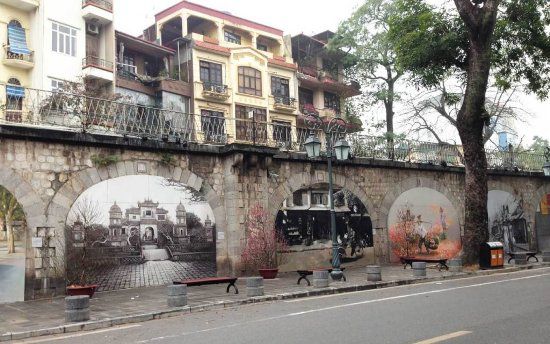
There are paintings on the street's wall
The artists used PU and Golden acrylics to draw the murals with a durability of 5 to 10 years, pasted it to the vaults in order not to affect the construction’s structure. Before drawing, the materials used to paint were all processed with a waterproof layer behind. Among these works, there are some murals were painted in 3 dimensions to form an effective interaction with the viewers. All of it evokes the nostalgia for both the local and tourists can easily receive Hanoi’s cultural value and history in a natural way.
Coming to Hanoi, don’t forget to stop by this mural street to enjoy the works of art which depict successfully the message of Vietnam’s capital. A thousand-year-old Hanoi is facing major changes. Yet, the city still upholds the spirit of tradition and culture to impress Vietnamese people and the friends around the world on their memory.
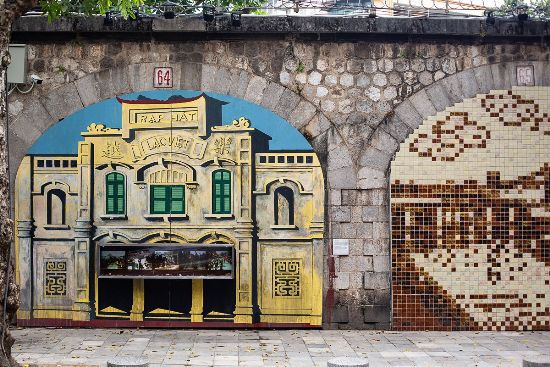
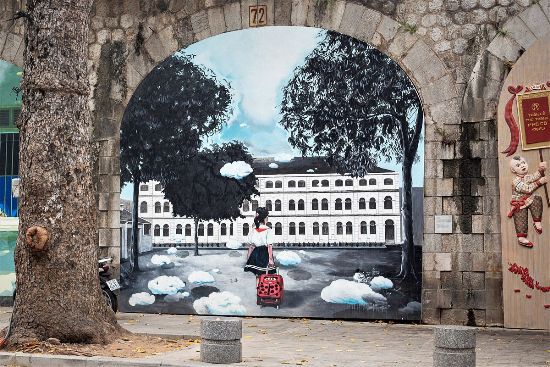
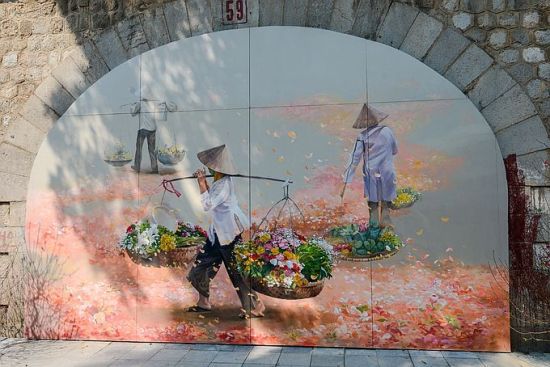
The paintings base on Hanoi iconic pictures of people daily life
With a length of 200 meters, Phung Hung mural street, which is close to Dong Xuan market, Hang Ma street, Hang Luoc street, is considered as a site for cultural exchanges. There are many entertainment activities, traditional folk games and performances held on the street. Phung Hung mural street is also a place connecting history and memory of Hanoi to the contemporary art right in the common space for the public.
At the weekends, children can come here with their families to play traditional folk games. The elderly goes there for contemplating the murals and think of their old days. The youngsters get their friends to take selfies, save the lovely moments of their youth. In addition, tables of tea and some traditional confectionary are displayed for the tourists to take a rest and photos like banh phu the (literally “husband and wife cake”, a sweet cake made of rice or tapioca flour and gelatin, filled with mung bean paste; also spelled banh xu xe), peanut brittle (a traditional candy made from roasted peanut, sugar and malt) and so on.
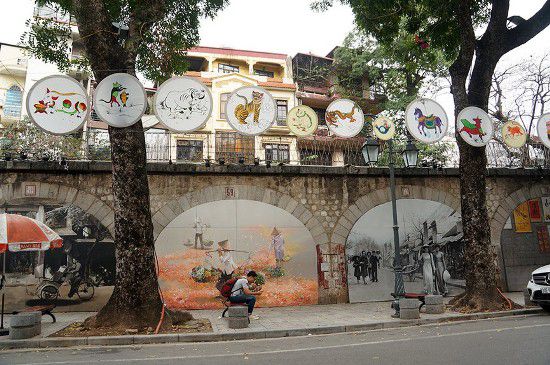
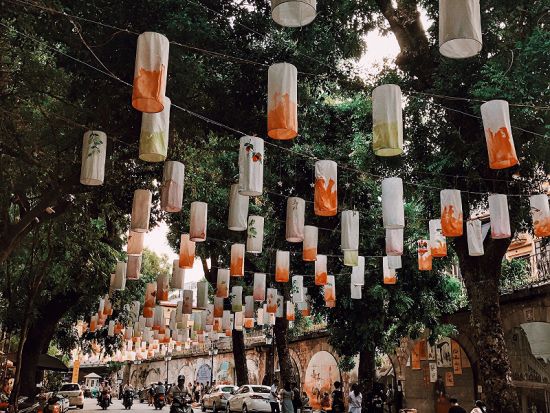
The locals decorate the street with different themes depending on the occasions.
Phung Hung mural street partly contributes to honor, uphold, and bring into play the social value of urban heritage of Hanoi Old Quarter. At the same time, it creates a new public space for the citizens, tourists in Hanoi. Paying this mural street a visit is also a chance for the public art works come closer to the people.
2. Hanoi Ceramic Road
The project “Ceramic Road” was first started by the idea of journalist/artist Nguyen Thu Thuy with the purpose of beautifying a public site with traditional ceramic through the hands of modern day artists. The project went into reality from 2007, covered a length of 4 kilometers and an acreage of 7000 square meters. Each square meter of wall paintings used approximately 1000 pieces of ceramic with the acreage of 3x3 centimeters. The road begins from An Duong gate on Yen Phu street, goes along the streets Tran Nhat Duat, Tran Quang Khai, Tran Khanh Du and all the way to the gate of Van Kiep.
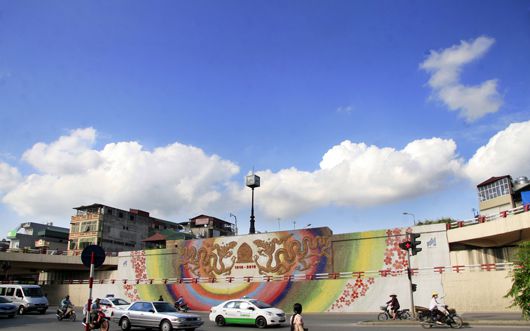
A part of the ceramic road after the project finished
According to journalist/artist Nguyen Thu Thuy, most of the funds poured into the structure came from the community, social investments and even the couple’s own money. Both of them spent a huge chunk of their fortune to maintain the project in its first days. Her husband, Mr. Cuong even had to sold his antique cars – his passion, in order to invest to the ceramic road along with his wife. “We did it without any personal gains besides unconditional love for Hanoi and the desire of improving the people’s living space, as well as promoting the traditional Vietnamese ceramic pottery to the world, and with the help from the community, the project turned out to be a huge success.”
Also according to Mrs. Thuy, during the 4 years of commencing the project, the Ceramic Road has attracted the participation of 20 domestic artists along with 15 foreign artists from various nations such as Denmark, France, Netherlands, Spain, Italia, England, USA, Argentina. Moreover, there were more than 100 artists, craftsmen from the pottery villages, and more than 500 citizens, including students and children have taken part in the project.
The road was divided into 21 parts: The 1st part honored the traditional artists’ legacies through various times in history, ever since the age of Dong Son to the Ly, Tran, Le, Nguyen dynasty along with a large image of a Ly dynasty styled dragon with the description “A thousand years of Thang Long – Hanoi” at the intersection of Chuong Duong Bridge. The 2nd part of the road represents the famous traditional patterns often found on clothes and architectural structures from 54 races in Vietnam. The 3rd part contains the paintings made by the Vietnamese children with the theme “Hanoi – The city of peace”. The parts from the 4th to the 9th are the modern day ceramic paintings made by both domestic and foreign artists, …
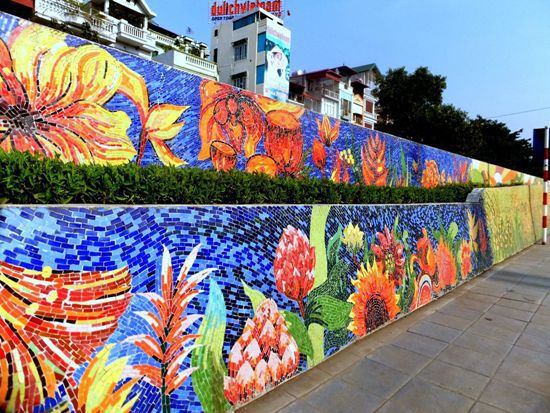
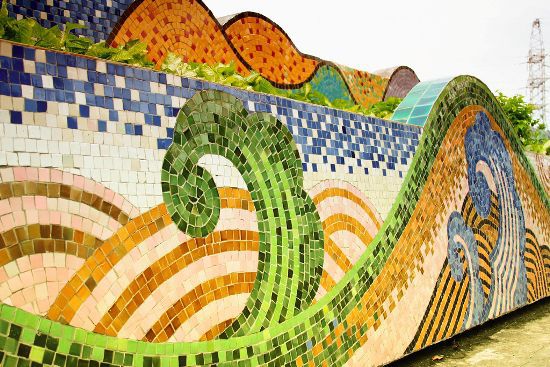
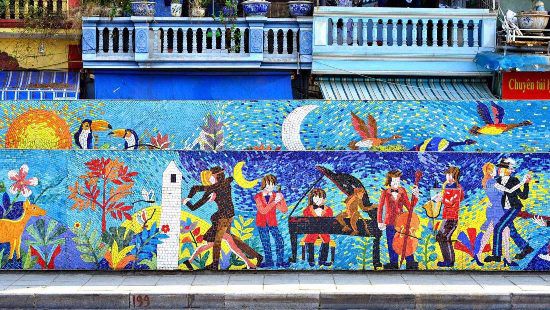
The colorful ceramic pictures running along the street
After 4 years, we finally have a colorful Ceramic Road, replacing the old and destructed concrete walls before. The Ceramic Road truly represents the assembled love to Hanoi – the heart of the country, from all around the world. The Guiness have recognized and certified the Ceramic Road of Hanoi as the largest ceramic assembled painting for the part from An Duong gate to Tan Ap gate.
The Ceramic Road by the side of Hong river is the first public structure in Hanoi that actually has many special meanings. Ever since the completion of the road, not only Hanoi has a precious gift dedicated to the 1000th year anniversary, but also the people of Vietnam have something in the record books for them to be proud of. The road has become an important destination that tourists should not be missed when they visit Hanoi. And above all, the country’s images and its culture values are effectively promoted to the world.
related destinations
Top 4 Resorts with Playground for Kids nearby Hanoi City Center
The hustle and bustle life of people who lives in big cities leading to the demand of relaxation and...The Temple of Literature - The first University of Thang Long Capital
Undergo over 1000 years of history, the Temple of Literature still be retained ancient beauty with...(+84) 3 87 86 68 52
Testimonials
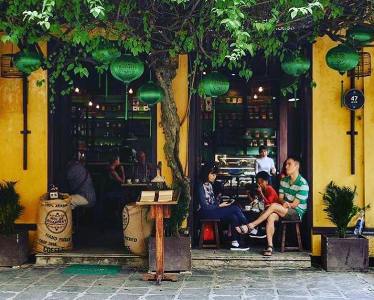
Excellent arrange, a really adapted proposal to our request
We were a group of 3 couples, chose FarEastour for our trip in Vietnam. We had some wishes:...
Highly recommended travel agency
We are very happy with our 22 days trip organized by Far East Tour! Our travel consultant,...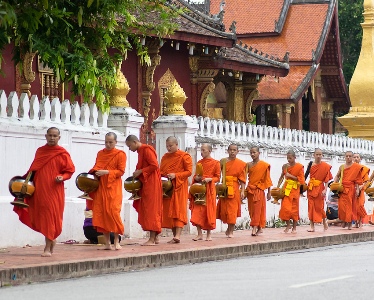
Dear Esther, I had a great time in Asia! You did arrange everything so perfect. Thank you so...

Touch with you again and remembering our unforgettable trip
Dear Christine, Hello, is good getting in touch with you again and remembering our unforgettable...
We had a very pleasant tour on Douce Mekong
Dear Wind, Thank you once again for your assistance, we had a very pleasant tour on Douce...
The trip to Ha Long Bay exceeded my expectations
Morning Esther, Now that I have returned to Australia I just wanted to send you a quick...
My trip to Sapa with your company has been great
Thanks a lot for your collaboration. About my trip to Sapa with your company has been great. The...
13 Days From Hanoi to Mekong with lots of happiness
We have been very happy having Mr Cong as a guide for Hanoi, and our cruise in Halong Bay was...
We asked Far East to put together a tour of Vietnam from north to south. They promptly emailed a...

Very professional and experienced travel agent
Very friendly and professional travel agent. Good advice given on what type of journey suits you....
I recommended your company to our travel agent in Germany
Dear Christine, Everything was fine, also the food. And for the vegetarian they tried special... Vietnam Tours
Vietnam Tours Vietnam Touren
Vietnam Touren Voyage au Vietnam
Voyage au Vietnam 越南旅游
越南旅游 越南旅遊
越南旅遊
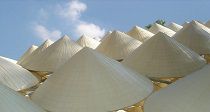

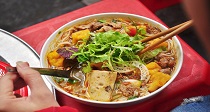
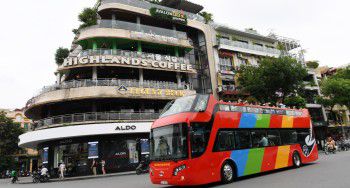

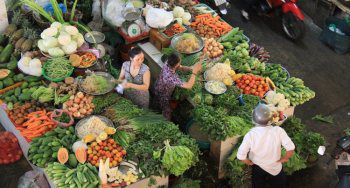

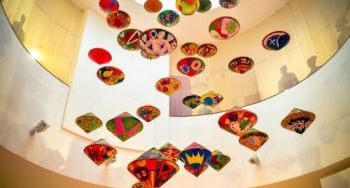
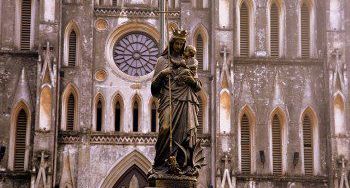




24/7